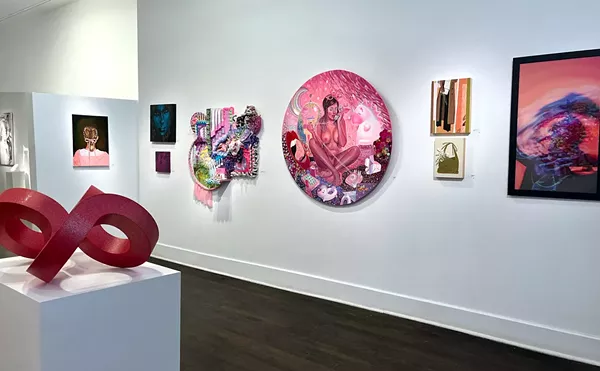
Audio By Carbonatix
[
{
"name": "GPT - Leaderboard - Inline - Content",
"component": "35519556",
"insertPoint": "5th",
"startingPoint": "3",
"requiredCountToDisplay": "3",
"maxInsertions": 100,
"adList": [
{
"adPreset": "LeaderboardInline"
}
]
}
]
At first glance, you wouldn’t be the first to mistake photographer Bruce Reinfeld’s photos for a casual Instagram shot, which is ironic because his style, he says, is largely a response to the ease and effortlessness often found in digital photography today; he calls it an “analog style for a digital world.”
Reinfeld, along with 1,100 other artists, will be exhibiting his crafts at this year’s Ann Arbor Art Fair, which takes place beginning on Wednesday, July 17, and ends Saturday, July 20, and will draw more than a half-million people to downtown Ann Arbor — and has nothing to do with weed.
“Working with 35 mm film bodies and $25 plastic Holga and Brownie cameras, I try to capture everyday elements of the world in a different perspective,” says Reinfeld, whose work combines the forgotten beauty of analog film and the capabilities of modern technology. “With a decade of traditional hand-coloring under my belt, I now airbrush the color digitally,” he says.
On his website, highfidelitydisco.com, the photographer sells his photos and T-shirts — nothing surprising — but he also has an interesting shopping category called “Jews Kick Ass,” and another with decorated skateboard decks — perhaps too artistic to actually use, but great for mounting on a living room wall.
Unlike many traveling shows that go from town to town, the Ann Arbor Art Fair has some history behind it. In 1959, a local merchant presented a then-novel idea to the Ann Arbor Art Association (now the Ann Arbor Art Center): Ask artists to show their work on the streets during the Ann Arbor merchants’ summer bargain days. According to artfair.org, the association board members’ initial reaction was, basically, “No good artist will sit in the street.”
The following year, the Ann Arbor Art Association, the University of Michigan, and two business groups established the Ann Arbor Street Art Fair — the granddaddy of the multifair event — creating one of the country’s first outdoor art fairs. And in 2004, AmericanStyle magazine named the Ann Arbor Street Art Fair No. 1 on their list of “Top 25 Fairs & Festivals,” and it has been ranked on the list nearly every year since.
Commonly known as the Art Fair, the event’s official title is actually the Ann Arbor Art Fairs, and consists of four independently juried art fairs, taking place simultaneously and contiguously throughout downtown Ann Arbor: the Ann Arbor’s South University Art Fair; Ann Arbor Street Art Fair, the Original; Ann Arbor Summer Art Fair; and, the State Street Area Art Fair.
This year’s event will feature street and music performances by 30 different bands, artist demonstrations, sidewalk sales, family-friendly activity zones and the Ann Arbor restaurant canon at its disposal — 150 restaurants and three outdoor food courts.
“It’s amazing to see the streets of Ann Arbor transformed into what is essentially a playground for art lovers,” says Karen Delhey, a spokeswoman for the Ann Arbor Art Fair. “This year’s fair offers a unique mix of some of the best art from around the world, with many favorite returning artists, as well as a number of artists who will make their debut.”
2012 Art Fair award-winner Beth Bojarski returns this year and has already begun attracting attention with her distinct style, which, academically defined, might be “to render common euphemisms, puns and expressions (i.e. “stumped,” “crabs” and “make pretty”) so as to reveal their humorous absurdity,” but that would omit another important aspect of her art: storytelling.
“As I am working, I’m asking myself, ‘Who is this person in front of me? Why are they interesting? What do they have to say?’” she asks. “I work to create a piece that has multiple layers … a strong visual image combined with an underlying story that is ever-changing.”
And it works. Her mildly disturbed caricatures, which also somehow manage to be cute and funny, invite the observer’s imagination to fill in and complete the subjects’ stories.
Also look out for Sooney Kadouh, a metro Detroit photographer born-and-raised. His work can be seen all around the city, from Pure Detroit to Yellow Door, and so can his subjects. Sooney photographs Detroit icons and retro brand logos (i.e. Better Made Chips and Vernor’s signs, the Ambassador Bridge and old Tiger Stadium), giving contemporary Detroit a classic feel, and completing them with bright, brilliant colors. “Bold art for a bold city,” he calls it.
Sooney and his company, Iconic Detroit, aim to engage and support Detroit and the metro community. They host photo safaris for kids, support emerging artists, and donate art as well as gallery sale profits to charitable organizations.
Perhaps as a sign that the state’s fortunes are picking up, after years of economic contraction, the Art Fair is poised to expand its offerings this year. “Despite the economic ups and downs in the state, the fair has continued to expand,” Ann Arbor resident and longtime Art Fair attendee Esther Ullman says, offering as an example the fair’s expansion to the Burton Memorial Tower area. “This was an inspired way to make it more of a town-gown event and bring in a lovely part of campus,” she says.
The Ann Arbor Art Fair takes place from July 17-20 in downtown Ann Arbor. For hours and more information, see artfair.org.
Zak Witus is an editorial intern at the Metro Times. Send comments to letters@metrotimes.com.





